Steel is a key component in modern building construction. Mild steel is the material of choice in building design because it is incredibly strong. If you hung a circular bar steel securely from your living room ceiling you could hang two and a half African elephants from it. It is mild steel’s incredible strength that makes it perfect for large, tall or industrial buildings.

Image by Manop, shared under a Creative Commons 2.0 License.
Benefits of mild steel in construction
Mild steel is flexible, it can bend without cracking. This property is particularly useful when a building will be constructed in an area where ground subsidence or earthquakes and tremors mean the building will have to flex and move with any slight changes to its foundations.
Mild steel’s third desirable quality is ductility. In simple terms this means that when force is applied to a steel sheet it will not crack or shatter, but slowly bend to adapt to the pressure. This quality means that steel performs far better than most other material under earthquake conditions.
You will find steel used in the construction of high rise buildings because it is strong, low in weight and construction can move at a rapid pace. Steel girders or sheets are made to the correct dimensions off site and then fitted in place. Steel is used in industrial buildings because it can span large spaces at low cost. You’ll probably be familiar with industrial estate units that are made up entirely of corrugated steel sheets. Similarly warehouse buildings are often built from durable, low cost steel.

Image by Ron Kroetz, shared under a Creative Commons 2.0 License.
Residential buildings can also be constructed from steel. A technique called light gauge construction is popular in the US and parts of Europe. Similar in many ways to wood framed construction – light gauge pieces are used in place of wood. Light gauge steel is thin steel sheets (1-3mm) that have been bent into shape to form C or Z shaped sections. These are then joined together to form the bones of the building.
Conventional steel fabrication is the name given to a process where fabricators cut steel sheets and beams to the right length and then weld them together in place on the building site. It is more common now that part of the construction is done in a workshop and the completed components fitted together on-site.
Bolted steel construction takes this to the next level. A series of steel building blocks are produced in the workshop, they are finished and painted and then bolted together like a huge Meccano set on-site. Some companies are able to offer pre-engineered buildings which are bolted steel buildings that are designed, abricated, shipped and constructed by one company.
So why should you build with steel?
Steel buildings are light compared to their concrete counterparts – sometimes up to 12 times lighter. They are super quick to construct, flexible so they offer longevity, and they can be made in any shape. They are versatile in appearance – cladding of many different types can be added to their exterior to suit the building’s use and setting.


